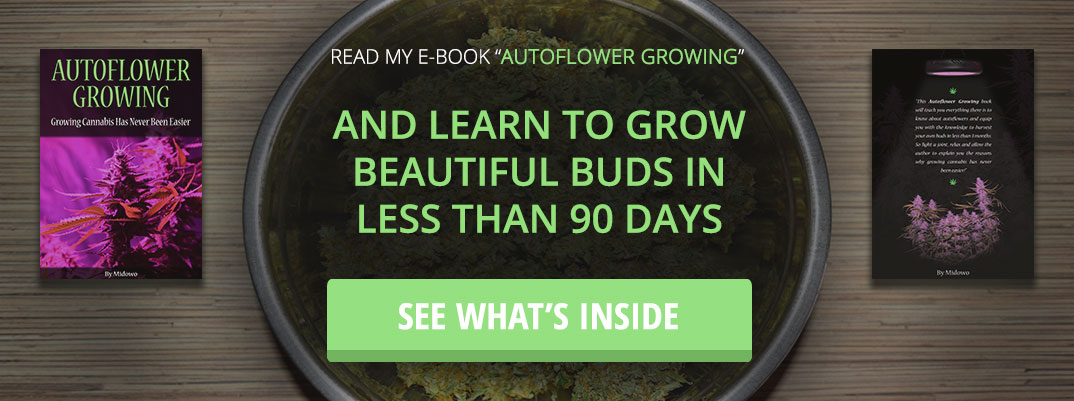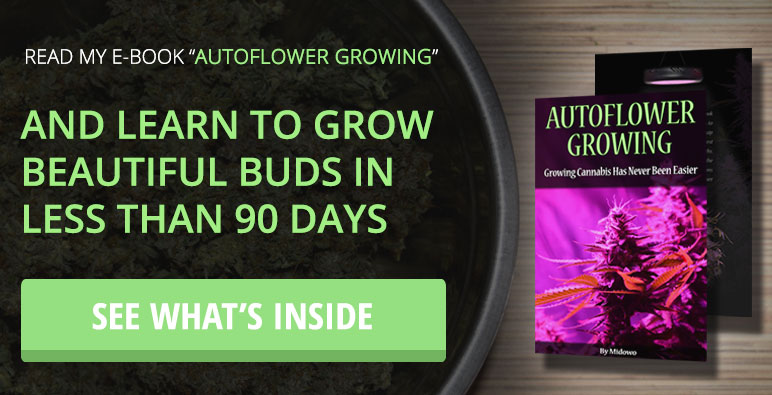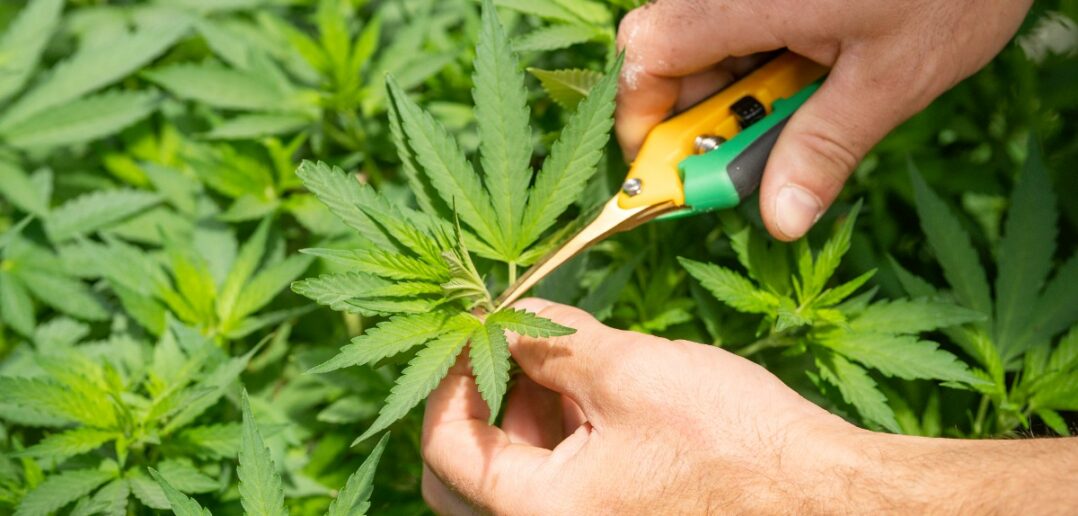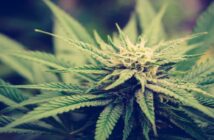Low-stress training has been used by cannabis growers globally as a way to increase yield and protect the plant from pests.
Various techniques that, when used at specific times in the growing cycle, can optimize energy distribution in flower growth and promote bud growth.
One technique that is neatly divided in the cannabis growing community is schwazzing and it is designed to give you some of the largest yields you can get from an indoor garden.
Schwazzing is a form of extreme defoliation that was promoted by Joshua Haupt in his book Three A Light where he claimed he could get 3 pounds of cannabis bud per 1000 watt light with this technique.
The idea is compared to human athleticism where the concept of breaking down your muscles multiple times will have them recover to a stronger state.
Translated to cannabis, this idea insinuates that if you take off almost all the fan leaves your plant will focus its energy on the buds, causing your yield and potency to increase.
While many claim that Haupt’s technique is effective there are still others who think leaving the plant intact is the best for the quality of the bud, and it continues to be a hot topic for debate.
Since defoliation is a common practice among growers, it makes sense that schwazzing is the next step in that evolution.
However, certain factors such as timing, overall plant health, and nutrition need to be addressed if schwazzing is to be used.
Let’s look at the specifics of this bud boosting technique and how it can benefit your autoflower cannabis garden.
The schwazzing process and benefits for your autoflower
Traditionally, schwazzing is an extreme form of defoliation used in the flower cycle of a cannabis plant after you have switched the light cycle to 12/12.
In the case of autoflowers and how they have no photoperiod requirements, it can get a little tricky. Most autoflower strains will start to flower in 5 or 6 weeks which is a good time to start looking at schwazzing your plant. A good sign to look out for is when the plant starts showing pistils.
The idea is to cut away all the fan leaves so that there is optimal airflow throughout the flowers and optimal light penetration to the bottom which forces the plant to focus its energy on growing flowers.
Using this method eliminates all fan leaves on your cannabis plant and just leaves the growing flowers.
Schwazzing as a defoliation tool has additional benefits, including:
- Extra airflow within the plant to help control pests. With no leaves to eat or hide in pests will have a harder time proliferating.
- Allowing light to penetrate the canopy for even distribution. Also reduces microclimates where mold and mildew can hide.
- Less defoliation needed at the end of the grow cycle means less chance to damage the flowers.
Growers using this technique generally do it once during the flower cycle for autoflower cannabis. The fan leaf culling is done when you start seeing pistils come out on your plant.
You can wait a little longer if you want, but know that if you do it too late it will impact the bud development and potentially cause a hermaphroditic plant.
Ensure that you finish schwazzing your plants all on the same day as the watering requirements for your plants will lower while the plant gets over the stress.
If you use this technique too early then your plant will have to work to grow the fan leaves back which will stunt the growth of the flowers.
If done correctly your autoflower plant should go into overdrive and start producing dense flowers covered in trichomes while it finishes up the growth cycle.
One way to assess if you’re done schwazzing your autoflower is to lay your hand under your plant and see if the light shows through the canopy.
Ensure that you are providing ample nutrition for the plant as it will have limited capacity for photosynthesis production after schwazzing.
A nutrient solution recipe will have to be customized as you will have to increase the macronutrients (phosphorus, potassium, and even nitrogen) and watch the plant for any signs of deficiency or excess stress.
While the technique itself is simple to understand, the debate within the growing community has a few different outlooks on why it works.
Schwazzing used as pest control for your autoflowers
Seldom looked at when considering pest control for your plant, schwazzing can provide some hidden benefits in regards to preventative measures.
While many growers boast a clean garden with plants that are disease-free, every grower has experienced things such as powdery mildew and spider mites lurking in their garden.
Stripping all of the fan leaves from your plant is a great deterrent for all of these pests as they rely on the canopy for food or to proliferate.
Powdery mildew loves to live on the fan leaves while spider mites use fan leaves for food and to make their webbing. Without a suitable environment for them to live in then your risk of pests is significantly lowered.
One consideration for schwazzing can be that your flowers are more vulnerable to pests without the fan leaves. An example of this can be found in the progression of powdery mildew.
Initially, it starts in the fan leaves and if left unchecked can make its way into the flower and eventually cause bud rot in the last weeks of the cycle.
If there are no fan leaves then any powdery mildew can make its way onto the sweetleaf and directly into the developing bud much quicker.
If you are going to use schwazzing on your autoflower cannabis then ensure that you have a consistent climate and are vigilant in your plant observations to quickly correct any problems.
How to manage your autoflowers health after schwazzing
Nutrition is an important part of the autoflower plant life cycle and is especially when you use schwazzing.
Mass defoliation of your cannabis plant can hinder potential growth as you are effectively cutting off its way of getting food.
Photosynthesis will still occur as the leaves grow back. You will need to ensure that you use the right combination of nutrients to make sure that the plant can make the most of the energy you are trying to give it.
Fan leaves are vital to your autoflowers development, and using this advanced technique has some inherent risks:
- Glucose and other carbohydrates are produced in the leaves using photosynthesis. Taking all of the leaves off will severely hinder that process and potentially stunt your plant.
- Fan leaves transport and produces the necessary hormones for plant development. Without them, flowers can have a hard time growing.
- Cannabis uses its fan leaves to release the C02 it consumed in the form of oxygen and water vapor. Your plant will have a difficult time cooling itself down and will get stressed.
If you have a strain that is a heavy feeder then make sure you are watering it on a regular basis.
Progressing through the flowering cycle the plant requires a higher concentration of macro and micronutrients.
Phosphorus ensures the flowers grow nice and large by making nutrient availability higher and potassium keeps the glucose production high to provide energy for the developing flowers.
The key here is to give the plants everything it needs to recover from the high stress of schwazzing while giving them the energy to put their focus towards flower production. It’s a fine balance but with any growing techniques, it will need to be tested and refined until you find your optimal setup.
During the flower cycle, a cannabis plant requires direct light for flowers to develop.
When fan leaves grow to accommodate the plant’s need for additional energy there is a tendency for the flowers on the lower part of the plant to be underdeveloped. Schwazzing eliminates any obstacles for those bottom flowers and they will receive all the light they will need.
Expect some incredible growth as those lower branches surge upwards to grow as big as they possibly can.
If you are familiar with low-stress training techniques you can create a tabletop canopy using topping techniques which, when combined with schwazzing, allows all of your colas to push upwards with no hindrance.
Not only will it look spectacular but the probability of massive and dense flowers is pretty good.
Exercise some caution though as your buds increase in size there is a chance of overcrowding and the potential for them to fall over so don’t forget to trellis your plant.
Is schwazzing a viable technique for your autoflower garden?
While the debate on whether or not schwazzing is a viable technique rages on, the science on schwazzing all cannabis (not just autoflowers) makes sense from a horticultural perspective.
Ideally, you want all of the things that schwazzing provides for optimal flower harvests.
Concerns regarding this technique being used are generally around timing and the health of the plant. If your particular strain or phenotype isn’t robust then the weak genetics can potentially hinder the results of schwazzing as the plant won’t recover.
Certain diseases such as root rot can be devastating while a cannabis plant is under duress. Without fan leaves, nutrient deficiencies can be difficult to diagnose because they generally start showing in those areas.
As with any advanced cannabis training technique, there are handoffs to the payouts but in the right hands, growers can make the most of schwazzing.
Here are some things to remember if you decide to use schwazzing as a technique in your garden:
- Ensure you are using a 1000 Watt light as the plant will need as much light as it can get.
- Carefully watch the climate in your grow room to ensure your plant doesn’t need to work harder than it already is.
- Provide ample nutrition and keep an eye on your PH and electrical conductivity.
- Do not mass defoliate more than the specified times or you risk damaging your plant and final yield.
There are many considerations to contemplate when deciding if schwazzing is right for your autoflower cannabis plant. This technique is designed for optimal flower growth and with all the benefits it provides, it is a powerful tool.
Remember to read your autoflower cannabis plant before attempting this as special care will be needed for the first few weeks of flowering.
Any signs of excessive stress need to be addressed right away or you won’t maximize your yields.







